Biochar Input to Saline-Alkali Farmland Can Improve Soil Health and Crop Yield: A Meta-Analysis
Abstract
1. Introduction
2. Materials and Methods
2.1. Data Collection
2.2. Data Categorization
2.3. Meta-Analysis
2.4. Data Analysis
3. Results
3.1. Dataset Overview
3.2. Climatic Conditions
3.3. Biochar Application: Type and Amount
3.4. Soil Classification, Production System, and Planting Pattern
3.5. Water Use Efficiency and Greenhouse Gas Emissions
3.6. Crop Types and Variable Importance
3.7. SEM Analysis
4. Discussion
4.1. The Overall Impact of Adding Biochar to Saline-Alkali Soils
4.2. The Role of Climatic Conditions, Soil Conditions, and Agricultural Management Practices
4.3. The Economic Feasibility of Biochar
5. Conclusions
Supplementary Materials
Author Contributions
Funding
Data Availability Statement
Acknowledgments
Conflicts of Interest
References
- Shrivastava, P.; Kumar, R. Soil salinity: A serious environmental issue and plant growth promoting bacteria as one of the tools for its alleviation. Saudi J. Biol. Sci. 2015, 22, 123–131. [Google Scholar] [CrossRef]
- Ivushkin, K.; Bartholomeus, H.; Bregt, A.K.; Pulatov, A.; Kempen, B.; de Sousa, L. Global mapping of soil salinity change. Remote Sens. Environ. 2019, 231, 111260. [Google Scholar] [CrossRef]
- Gao, H.; Fu, T.G.; Wang, F.; Zhang, M.; Qi, F.; Liu, J.T. Influence of groundwater table depth on the evolution of saline-alkali land in a coastal area. Land Degrad. Dev. 2024, 35, 2857–2866. [Google Scholar] [CrossRef]
- Gopinath, K.P.; Vo, D.V.N.; Prakash, D.G.; Joseph, A.A.; Viswanathan, S.; Arun, J. Environmental applications of carbon-based materials: A review. Environ. Chem. Lett. 2021, 19, 557–582. [Google Scholar] [CrossRef]
- Oliveira, F.R.; Patel, A.K.; Jaisi, D.P.; Adhikari, S.; Lu, H.; Khanal, S.K. Environmental application of biochar: Current status and perspectives. Bioresour. Technol. 2017, 246, 110–122. [Google Scholar] [CrossRef] [PubMed]
- Zhang, C.; Zeng, G.M.; Huang, D.L.; Lai, C.; Chen, M.; Cheng, M.; Tang, W.W.; Tang, L.; Dong, H.R.; Huang, B.B.; et al. Biochar for environmental management: Mitigating greenhouse gas emissions, contaminant treatment, and potential negative impacts. Chem. Eng. J. 2019, 373, 902–922. [Google Scholar] [CrossRef]
- Si, T.R.; Chen, X.; Yuan, R.; Pan, S.Y.; Wang, Y.; Bian, R.J.; Liu, X.Y.; Zhang, X.H.; Joseph, S.; Li, L.Q.; et al. Iron-modified biochars and their aging reduce soil cadmium mobility and inhibit rice cadmium uptake by promoting soil iron redox cycling. J. Environ. Manag. 2024, 370, 122848. [Google Scholar] [CrossRef]
- Thauront, J.L.; Soja, G.; Schmidt, H.P.; Abiven, S. A critical re-analysis of biochar properties prediction from production parameters and elemental analysis. GCB Bioenergy 2024, 16, e13170. [Google Scholar] [CrossRef]
- Mounissamy, V.C.; Chandrashekar, D.P.; Adhikari, T.; Sarkar, A.; Lenka, S.; Selladurai, R.; Yadav, D.K.; Saha, M.; Meena, B.P.; Ajay; et al. Priming Effect of Pigeon Pea and Wood Biochar on Carbon Mineralization of Native Soil Organic Carbon and Applied Municipal Solid Waste Compost. BioResources 2024, 19, 7478–7492. [Google Scholar] [CrossRef]
- Bekchanova, M.; Kuppens, T.; Cuypers, A.; Jozefczak, M.; Malina, R. Biochar’s effect on the soil carbon cycle: A rapid review and meta-analysis. Biochar 2024, 6, 88. [Google Scholar] [CrossRef]
- Gross, A.; Bromm, T.; Polifka, S.; Fischer, D.; Glaser, B. Long-term biochar and soil organic carbon stability—Evidence from field experiments in Germany. Sci. Total Environ. 2024, 954, 176340. [Google Scholar] [CrossRef] [PubMed]
- Wang, X.J.; Zhu, Z.; Huang, N.; Wu, L.P.; Lu, T.P.; Hu, Z.J. Impacts of biochar amendment and straw incorporation on soil heterotrophic respiration and desorption of soil organic carbon. Geosci. Lett. 2023, 10, 38. [Google Scholar] [CrossRef]
- Thomas, S.C.; Ruan, R.Y.; Gale, N.V.; Gezahegn, S. Phytotoxicity and hormesis in common mobile organic compounds in leachates of wood-derived biochars. Biochar 2024, 6, 51. [Google Scholar] [CrossRef]
- Cayuela, M.L.; Jeffery, S.; van Zwieten, L. The molar H:Corg ratio of biochar is a key factor in mitigating N2O emissions from soil. Agric. Ecosyst. Environ. 2015, 202, 135–138. [Google Scholar] [CrossRef]
- Kaur, N.; Kieffer, C.; Ren, W.; Hui, D.F. How much is soil nitrous oxide emission reduced with biochar application? An evaluation of meta-analyses. GCB Bioenergy 2023, 15, 24–37. [Google Scholar] [CrossRef]
- Yang, S.; Hao, X.H.; Xu, Y.M.; Yang, J.J.; Su, D.R. Meta-Analysis of the Effect of Saline-Alkali Land Improvement and Utilization on Soil Organic Carbon. Life 2022, 12, 1870. [Google Scholar] [CrossRef]
- Fan, X.P.; Yin, C.; Yan, G.C.; Cui, P.Y.; Shen, Q.; Wang, Q.; Chen, H.; Zhang, N.; Ye, M.J.; Zhao, Y.H.; et al. The contrasting effects of N-(n-butyl) thiophosphoric triamide (NBPT) on N2O emissions in arable soils differing in pH are underlain by complex microbial mechanisms. Sci. Total Environ. 2018, 642, 155–167. [Google Scholar] [CrossRef]
- Mei, K.; Wang, Z.F.; Huang, H.; Zhang, C.; Shang, X.; Dahlgren, R.A.; Zhang, M.H.; Xia, F. Stimulation of N2O emission by conservation tillage management in agricultural lands: A meta-analysis. Soil Tillage Res. 2018, 182, 86–93. [Google Scholar] [CrossRef]
- Philibert, A.; Loyce, C.; Makowski, D. Assessment of the quality of meta-analysis in agronomy. Agric. Ecosyst. Environ. 2012, 148, 72–82. [Google Scholar] [CrossRef]
- Du, Y.Q.; Liu, X.F.; Zhang, L.; Zhou, W. Drip irrigation in agricultural saline-alkali land controls soil salinity and improves crop yield: Evidence from a global meta-analysis. Sci. Total Environ. 2023, 880, 163226. [Google Scholar] [CrossRef]
- Hedges, L.V.; Gurevitch, J.; Curtis, P.S. The meta-analysis of response ratios in experimental ecology. Ecology 1999, 80, 1150–1156. [Google Scholar] [CrossRef]
- Adu, M.O.; Yawson, D.O.; Armah, F.A.; Asare, P.A.; Frimpong, K.A. Meta-analysis of crop yields of full, deficit, and partial root-zone drying irrigation. Agric. Water Manag. 2018, 197, 79–90. [Google Scholar] [CrossRef]
- Yan, X.J.; Chen, X.H.; Ma, C.C.; Cai, Y.Y.; Cui, Z.L.; Chen, X.P.; Wu, L.Q.; Zhang, F.S. What are the key factors affecting maize yield response to and agronomic efficiency of phosphorus fertilizer in China? Field Crops Res. 2021, 270, 108221. [Google Scholar] [CrossRef]
- Zhang, L.Q.; Wang, Y.L.; Lou, Z.X.; Hsu, L.F.; Chen, D.; Piao, R.Z.; Zhao, H.Y.; Cui, Z.J. Meta-Analysis of Factors Affecting C-N Fractions and Yield of Paddy Soils by Total Straw Return and N Fertilizer Application. Agronomy 2022, 12, 3168. [Google Scholar] [CrossRef]
- Xin, J.L. Enhancing soil health to minimize cadmium accumulation in agro-products: The role of microorganisms, organic matter, and nutrients. Environ. Pollut. 2024, 348, 123890. [Google Scholar] [CrossRef] [PubMed]
- Zhang, Y.F.; Wang, J.M.; Feng, Y. The effects of biochar addition on soil physicochemical properties: A review. Catena 2021, 202, 105284. [Google Scholar] [CrossRef]
- Shaygan, M.; Reading, L.P.; Baumgartl, T. Effect of physical amendments on salt leaching characteristics for reclamation. Geoderma 2017, 292, 96–110. [Google Scholar] [CrossRef]
- Akhtar, S.S.; Andersen, M.N.; Liu, F.L. Residual effects of biochar on improving growth, physiology and yield of wheat under salt stress. Agric. Water Manag. 2015, 158, 61–68. [Google Scholar] [CrossRef]
- Zheng, H.; Wang, X.; Chen, L.; Wang, Z.Y.; Xia, Y.; Zhang, Y.P.; Wang, H.F.; Luo, X.X.; Xing, B.S. Enhanced growth of halophyte plants in biochar-amended coastal soil: Roles of nutrient availability and rhizosphere microbial modulation. Plant Cell Environ. 2018, 41, 517–532. [Google Scholar] [CrossRef]
- Tang, J.W.; Zhang, S.D.; Zhang, X.T.; Chen, J.H.; He, X.Y.; Zhang, Q.Z. Effects of pyrolysis temperature on soil-plant-microbe responses to Solidago canadensis L. -derived biochar in coastal saline -alkali soil. Sci. Total Environ. 2020, 731, 138938. [Google Scholar] [CrossRef]
- Hossain, M.K.; Strezov, V.; Chan, K.Y.; Ziolkowski, A.; Nelson, P.F. Influence of pyrolysis temperature on production and nutrient properties of wastewater sludge biochar. J. Environ. Manag. 2011, 92, 223–228. [Google Scholar] [CrossRef] [PubMed]
- Awad, Y.M.; Wang, J.Y.; Igalavithana, A.D.; Tsang, D.C.W.; Kim, K.H.; Lee, S.S.; Ok, Y.S. Biochar Effects on Rice Paddy: Meta-analysis. In Advances in Agronomy; Sparks, D.L., Ed.; Elsevier Academic Press Inc: San Diego, CA, USA, 2018; Volume 148, pp. 1–32. [Google Scholar]
- Islam, T.; Li, Y.L.; Cheng, H.F. Biochars and Engineered Biochars for Water and Soil Remediation: A Review. Sustainability 2021, 13, 9932. [Google Scholar] [CrossRef]
- Wu, Y.; Xu, G.; Shao, H.B. Furfural and its biochar improve the general properties of a saline soil. Solid Earth 2014, 5, 665–671. [Google Scholar] [CrossRef]
- Zhao, B.W.; Nan, X.J.; Xu, H.; Zhang, T.; Ma, F.F. Sulfate sorption on rape (Brassica campestris L.) straw biochar, loess soil and a biochar-soil mixture. J. Environ. Manag. 2017, 201, 309–314. [Google Scholar] [CrossRef]
- Yue, Y.; Guo, W.N.; Lin, Q.M.; Li, G.T.; Zhao, X.R. Improving salt leaching in a simulated saline soil column by three biochars derived from rice straw (Oryza sativa L.), sunflower straw (Helianthus annuus), and cow manure. J. Soil Water Conserv. 2016, 71, 467–475. [Google Scholar] [CrossRef]
- Wang, L.W.; O’Connor, D.; Rinklebe, J.; Ok, Y.S.; Tsang, D.C.W.; Shen, Z.T.; Hou, D.Y. Biochar Aging: Mechanisms, Physicochemical Changes, Assessment, And Implications for Field Applications. Environ. Sci. Technol. 2020, 54, 14797–14814. [Google Scholar] [CrossRef]
- Fungo, B.; Lehmann, J.; Kalbitz, K.; Tenywa, M.; Thiongo, M.; Neufeldt, H. Emissions intensity and carbon stocks of a tropical Ultisol after amendment with Tithonia green manure, urea and biochar. Field Crops Res. 2017, 209, 179–188. [Google Scholar] [CrossRef] [PubMed]
- Thers, H.; Djomo, S.N.; Elsgaard, L.; Knudsen, M.T. Biochar potentially mitigates greenhouse gas emissions from cultivation of oilseed rape for biodiesel. Sci. Total Environ. 2019, 671, 180–188. [Google Scholar] [CrossRef] [PubMed]
- Galan-Martin, A.; Contreras, M.D.; Romero, I.; Ruiz, E.; Bueno-Rodriguez, S.; Eliche-Quesada, D.; Castro-Galiano, E. The potential role of olive groves to deliver carbon dioxide removal in a carbon-neutral Europe: Opportunities and challenges. Renew. Sust. Energ. Rev. 2022, 165, 112609. [Google Scholar] [CrossRef]
- Mukherjee, A.; Lal, R. The biochar dilemma. Soil Res. 2014, 52, 217–230. [Google Scholar] [CrossRef]
- Wang, X.Y.; Lyu, J.; Zhu, H.; Shutes, B.; Xu, Y.Y.; Zhang, F.M. Reclaimed saline-alkali paddy field may be a hotspot of methane and ammonia emissions. Land Degrad. Dev. 2023, 34, 4869–4881. [Google Scholar] [CrossRef]
- Hu, M.; Qu, Z.Y.; Li, Y.; Xiong, Y.W.; Huang, G.H. Contrasting effects of different straw return modes on net ecosystem carbon budget and carbon footprint in saline-alkali arid farmland. Soil Tillage Res. 2024, 239, 106031. [Google Scholar] [CrossRef]
- Zhang, P.F.; Jiang, Z.W.; Wu, X.D.; Lu, Q.; Lin, Y.; Zhang, Y.Y.; Zhang, X.; Liu, Y.; Wang, S.Y.; Zang, S.Y. Effects of Biochar and Organic Additives on CO2 Emissions and the Microbial Community at Two Water Saturations in Saline-Alkaline Soil. Agronomy 2023, 13, 1745. [Google Scholar] [CrossRef]
- Wang, H.Y.; Chen, Y.Q.; Chen, L.; Liao, B.; Dai, Q.G.; Zhang, H.C.; Liao, P. Gypsum Application and Straw Incorporation Interact to Alleviate Methane Emissions in Coastal Saline-Alkali Rice Soils. J. Soil Sci. Plant Nutr. 2024, 24, 4398–4406. [Google Scholar] [CrossRef]
- Chen, M.M.; Zhang, S.R.; Liu, L.; Liu, J.G.; Ding, X.D. Organic fertilization increased soil organic carbon stability and sequestration by improving aggregate stability and iron oxide transformation in saline-alkaline soil. Plant Soil 2022, 474, 233–249. [Google Scholar] [CrossRef]
- Li, Y.F.; Hu, S.D.; Chen, J.H.; Müller, K.; Li, Y.C.; Fu, W.J.; Lin, Z.W.; Wang, H.L. Effects of biochar application in forest ecosystems on soil properties and greenhouse gas emissions: A review. J. Soils Sediments 2018, 18, 546–563. [Google Scholar] [CrossRef]
- Gu, Y.Y.; Zhang, H.Y.; Liang, X.Y.; Fu, R.; Li, M.; Chen, C.J. Impact of Biochar and Bioorganic Fertilizer on Rhizosphere Bacteria in Saline-Alkali Soil. Microorganisms 2022, 10, 2310. [Google Scholar] [CrossRef]
- Lashari, M.S.; Ye, Y.X.; Ji, H.S.; Li, L.Q.; Kibue, G.W.; Lu, H.F.; Zheng, J.F.; Pan, G.X. Biochar-manure compost in conjunction with pyroligneous solution alleviated salt stress and improved leaf bioactivity of maize in a saline soil from central China: A 2-year field experiment. J. Sci. Food Agric. 2015, 95, 1321–1327. [Google Scholar] [CrossRef]
- Ji, M.Y.; Wang, X.X.; Usman, M.; Liu, F.H.; Dan, Y.T.; Zhou, L.; Campanaro, S.; Luo, G.; Sang, W.J. Effects of different feedstocks-based biochar on soil remediation: A review. Environ. Pollut. 2022, 294, 118655. [Google Scholar] [CrossRef]
- Wei, Z.; Wang, J.J.; Fultz, L.M.; White, P.; Jeong, C. Application of biochar in estrogen hormone-contaminated and manure-affected soils: Impact on soil respiration, microbial community and enzyme activity. Chemosphere 2021, 270, 128625. [Google Scholar] [CrossRef]
- Cai, F.; Feng, Z.J.; Zhu, L.Z. Effects of biochar on CH4 emission with straw application on paddy soil. J. Soils Sediments 2018, 18, 599–609. [Google Scholar] [CrossRef]
- Yan, T.T.; Xue, J.H.; Zhou, Z.D.; Wu, Y.B. The Trends in Research on the Effects of Biochar on Soil. Sustainability 2020, 12, 7810. [Google Scholar] [CrossRef]
- Zhao, J.; Yang, Y.D.; Zhang, K.; Jeong, J.; Zeng, Z.H.; Zang, H.D. Does crop rotation yield more in China? A meta-analysis. Field Crops Res. 2020, 245, 107659. [Google Scholar] [CrossRef]
- Huang, R.L.; Zhang, Z.Y.; Xiao, X.; Zhang, N.; Wang, X.Y.; Yang, Z.P.; Xu, K.Q.; Liang, Y.T. Structural changes of soil organic matter and the linkage to rhizosphere bacterial communities with biochar amendment in manure fertilized soils. Sci. Total Environ. 2019, 692, 333–343. [Google Scholar] [CrossRef]
- Soothar, M.K.; Hamani, A.K.M.; Sootahar, M.K.; Sun, J.S.; Yang, G.; Bhatti, S.M.; Traore, A. Assessment of Acidic Biochar on the Growth, Physiology and Nutrients Uptake of Maize (Zea mays L.) Seedlings under Salinity Stress. Sustainability 2021, 13, 3150. [Google Scholar] [CrossRef]
- Wan, X.S.; Gong, F.M.; Qu, M.F.; Qiu, E.X.; Zhong, C.M. Experimental Study of the Salt Transfer in a Cold Sodium Sulfate Soil. KSCE J. Civ. Eng. 2019, 23, 1573–1585. [Google Scholar] [CrossRef]
- Bin Yousaf, M.T.; Nawaz, M.F.; Rehman, M.Z.U.; Gul, S.; Yasin, G.; Rizwan, M.; Ali, S. Effect of three different types of biochars on eco-physiological response of important agroforestry tree species under salt stress. Int. J. Phytoremediat. 2021, 23, 1412–1422. [Google Scholar] [CrossRef]
- Xin, B.X.; Yu, L.X.; Li, G.S.; Jiao, Y.; Liu, T.X.; Zhang, S.W.; Lei, Z.Y. Impact of Saline-Alkali Land Greening on the Local Surface Temperature—A Multiscale Assessment Based on Remote Sensing. Remote Sens. 2022, 14, 4246. [Google Scholar] [CrossRef]
- Wang, X.J.; Wang, J.Y.; Wang, J.P. Seasonality of soil respiration under gypsum and straw amendments in an arid saline-alkali soil. J. Environ. Manag. 2021, 277, 111494. [Google Scholar] [CrossRef]
- Wang, Z.X.; Cao, C.; Wang, Q.; Shen, J.J.; Han, M.X.; Xia, W.T.; Zhou, T.; Yu, Z.Y.; Shan, X.H. Analysis of the pore structure characteristics of saline soil in the profile within the frozen depth. Cold Reg. Sci. Technol. 2023, 212, 103882. [Google Scholar] [CrossRef]
- Jindo, K.; Mizumoto, H.; Sawada, Y.; Sanchez-Monedero, M.A.; Sonoki, T. Physical and chemical characterization of biochars derived from different agricultural residues. Biogeosciences 2014, 11, 6613–6621. [Google Scholar] [CrossRef]
- Mehdizadeh, L.; Moghaddam, M.; Lakzian, A. Amelioration of soil properties, growth and leaf mineral elements of summer savory under salt stress and biochar application in alkaline soil. Sci. Hortic. 2020, 267, 109319. [Google Scholar] [CrossRef]
- Chakraborty, K.; Bhaduri, D.; Meena, H.N.; Kalariya, K. External potassium (K+) application improves salinity tolerance by promoting Na+-exclusion, K+-accumulation and osmotic adjustment in contrasting peanut cultivars. Plant Physiol. Biochem. 2016, 103, 143–153. [Google Scholar] [CrossRef]
- Lefebvre, D.; Williams, A.; Kirk, G.J.D.; Meersmans, J.; Sohi, S.; Goglio, P.; Smith, P. An anticipatory life cycle assessment of the use of biochar from sugarcane residues as a greenhouse gas removal technology. J. Clean Prod. 2021, 312, 127764. [Google Scholar] [CrossRef]
- Mohammadi, A.; Khoshnevisan, B.; Venkatesh, G.; Eskandari, S. A Critical Review on Advancement and Challenges of Biochar Application in Paddy Fields: Environmental and Life Cycle Cost Analysis. Processes 2020, 8, 1275. [Google Scholar] [CrossRef]
- Dickinson, D.; Balduccio, L.; Buysse, J.; Ronsse, F.; van Huylenbroeck, G.; Prins, W. Cost-benefit analysis of using biochar to improve cereals agriculture. GCB Bioenergy 2015, 7, 850–864. [Google Scholar] [CrossRef]
- Yang, X.; Zhang, S.Q.; Ju, M.T.; Liu, L. Preparation and Modification of Biochar Materials and their Application in Soil Remediation. Appl. Sci. 2019, 9, 1365. [Google Scholar] [CrossRef]
- Lu, X.Y.; Guo, W.J.; Wang, B.Y.; Feng, Y.F.; He, S.Y.; Xue, L.H. Screening optimal preparation conditions of low-cost metal-modified biochar for phosphate adsorption and unraveling their influence on adsorption performance. J. Clean Prod. 2023, 425, 138927. [Google Scholar] [CrossRef]
- Masek, O.; Buss, W.; Sohi, S. Standard Biochar Materials. Environ. Sci. Technol. 2018, 52, 9543–9544. [Google Scholar] [CrossRef]
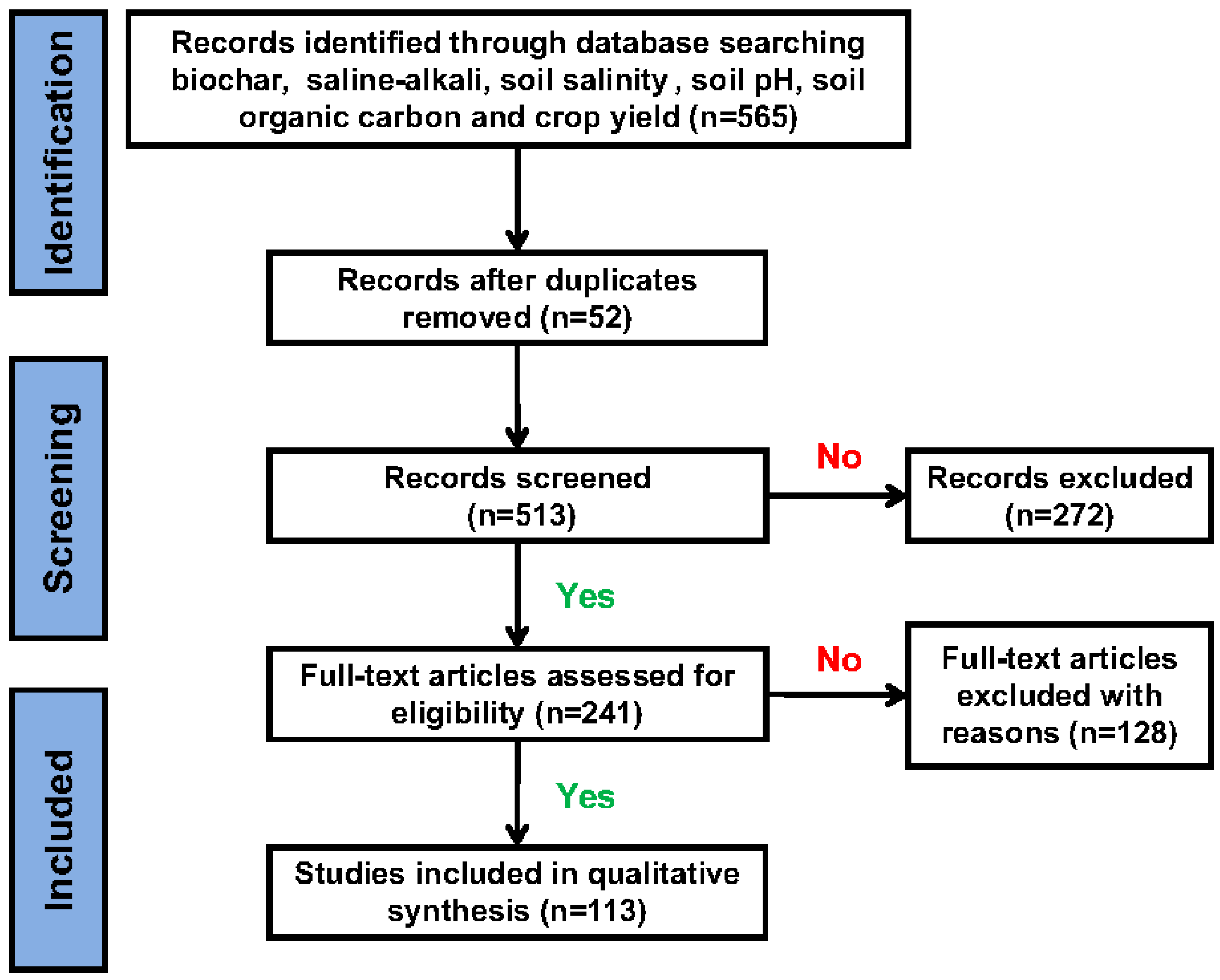
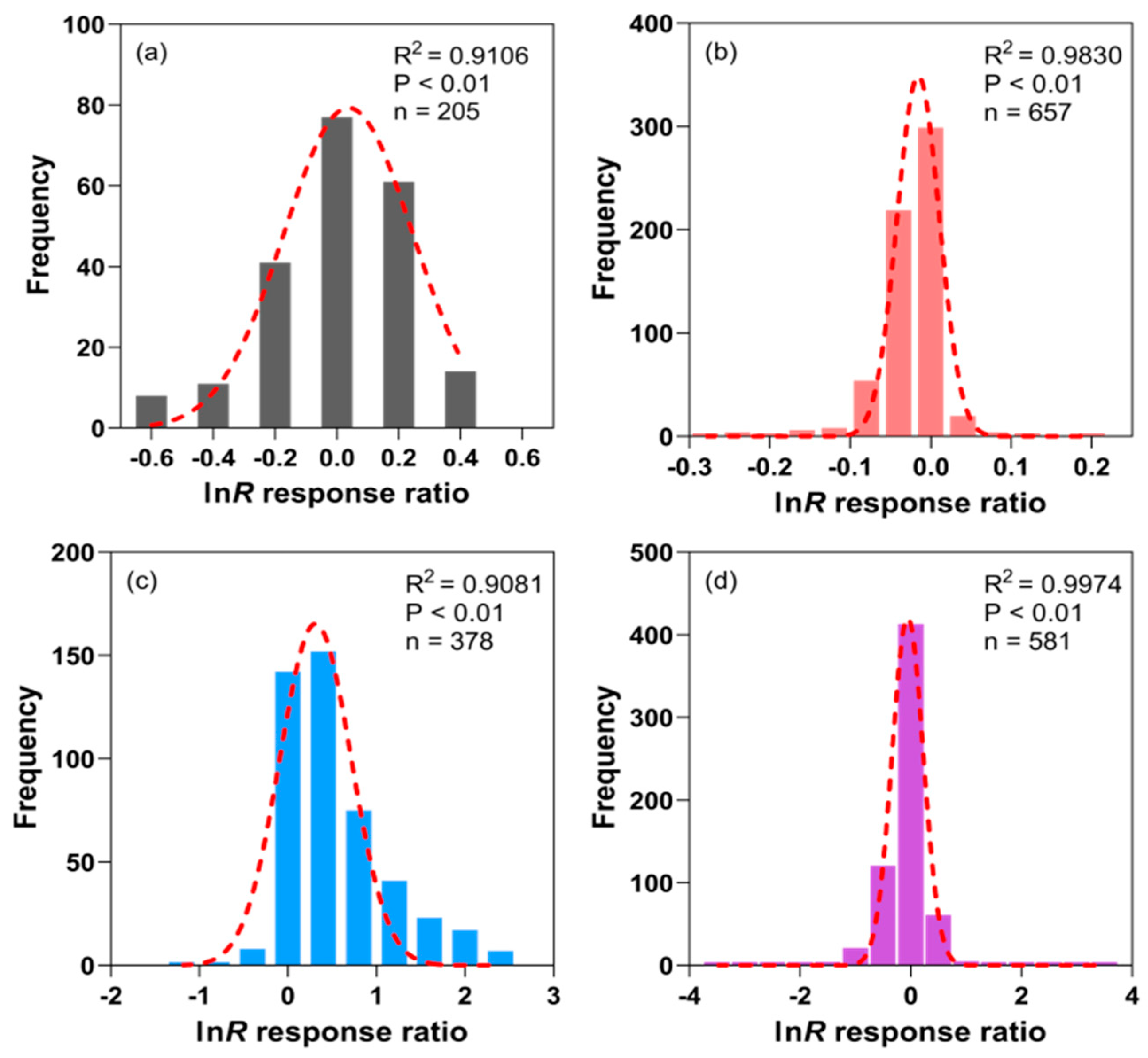
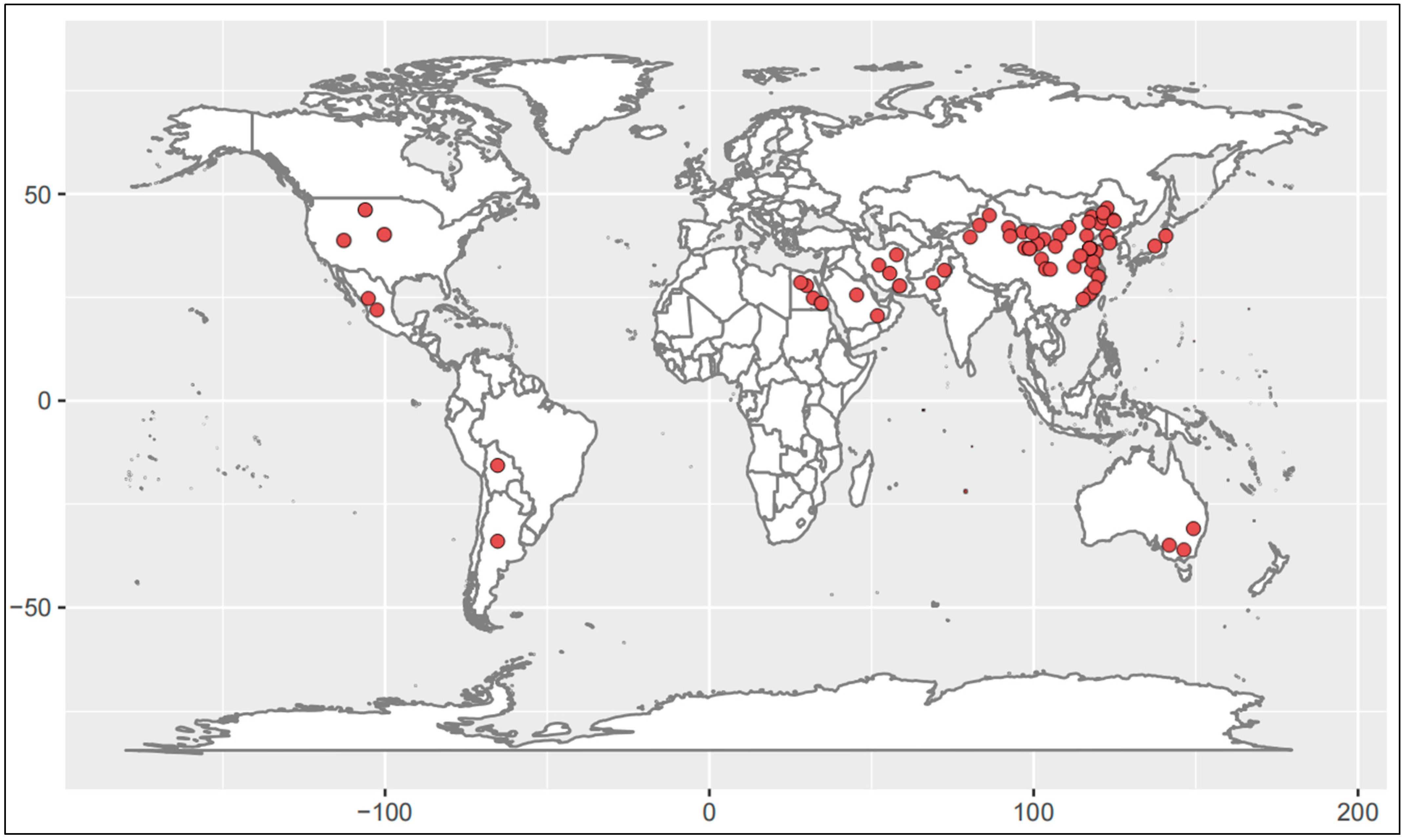
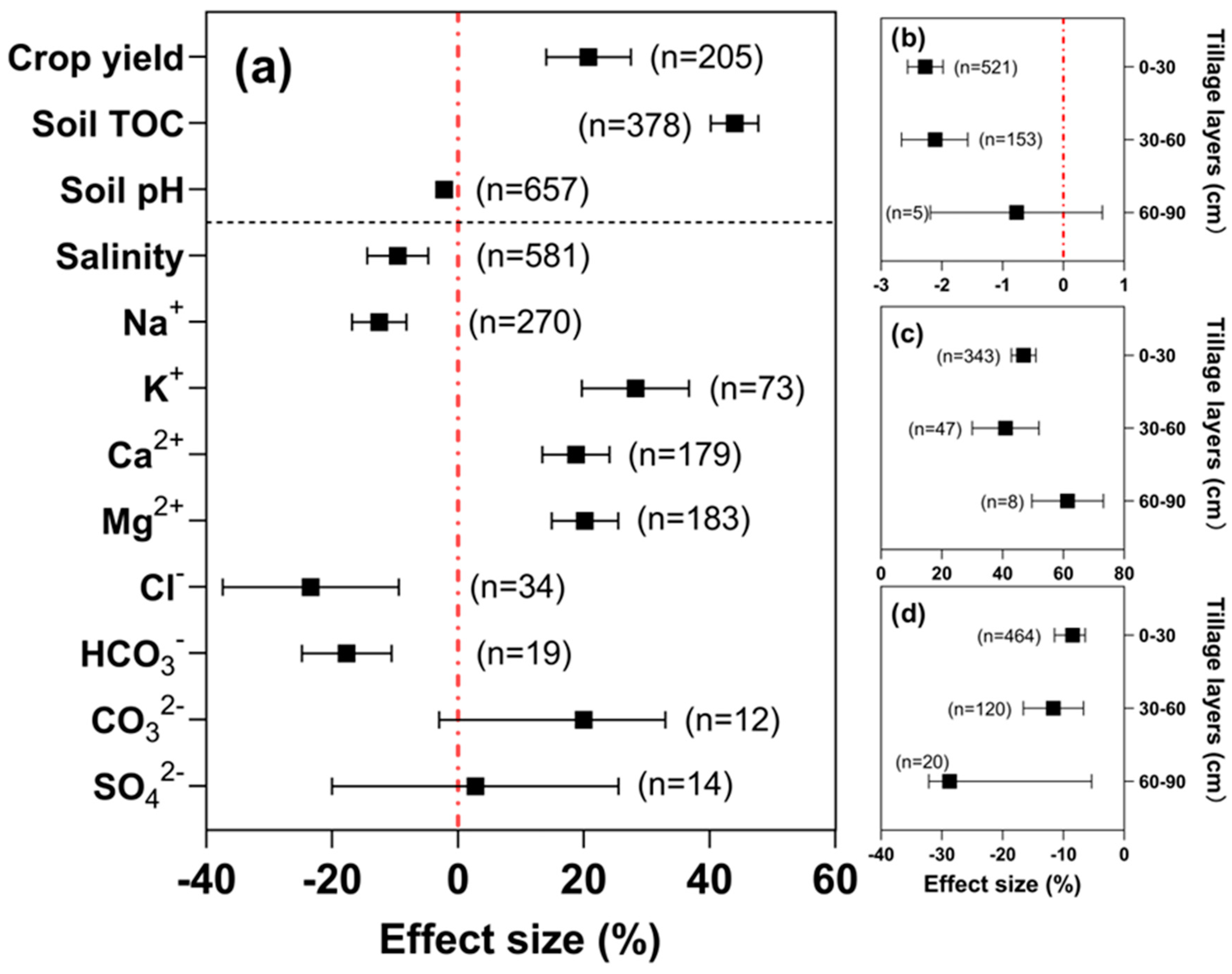

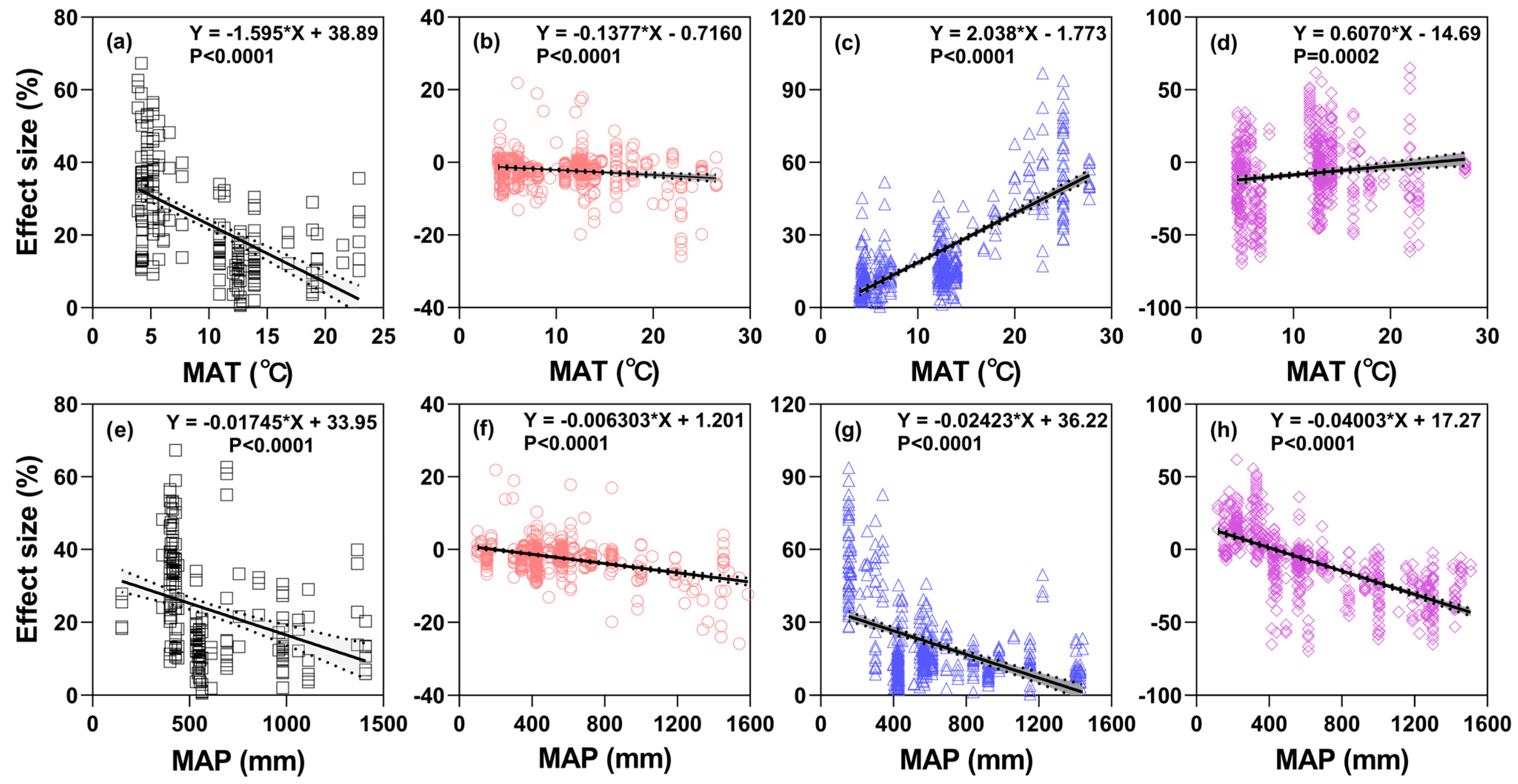
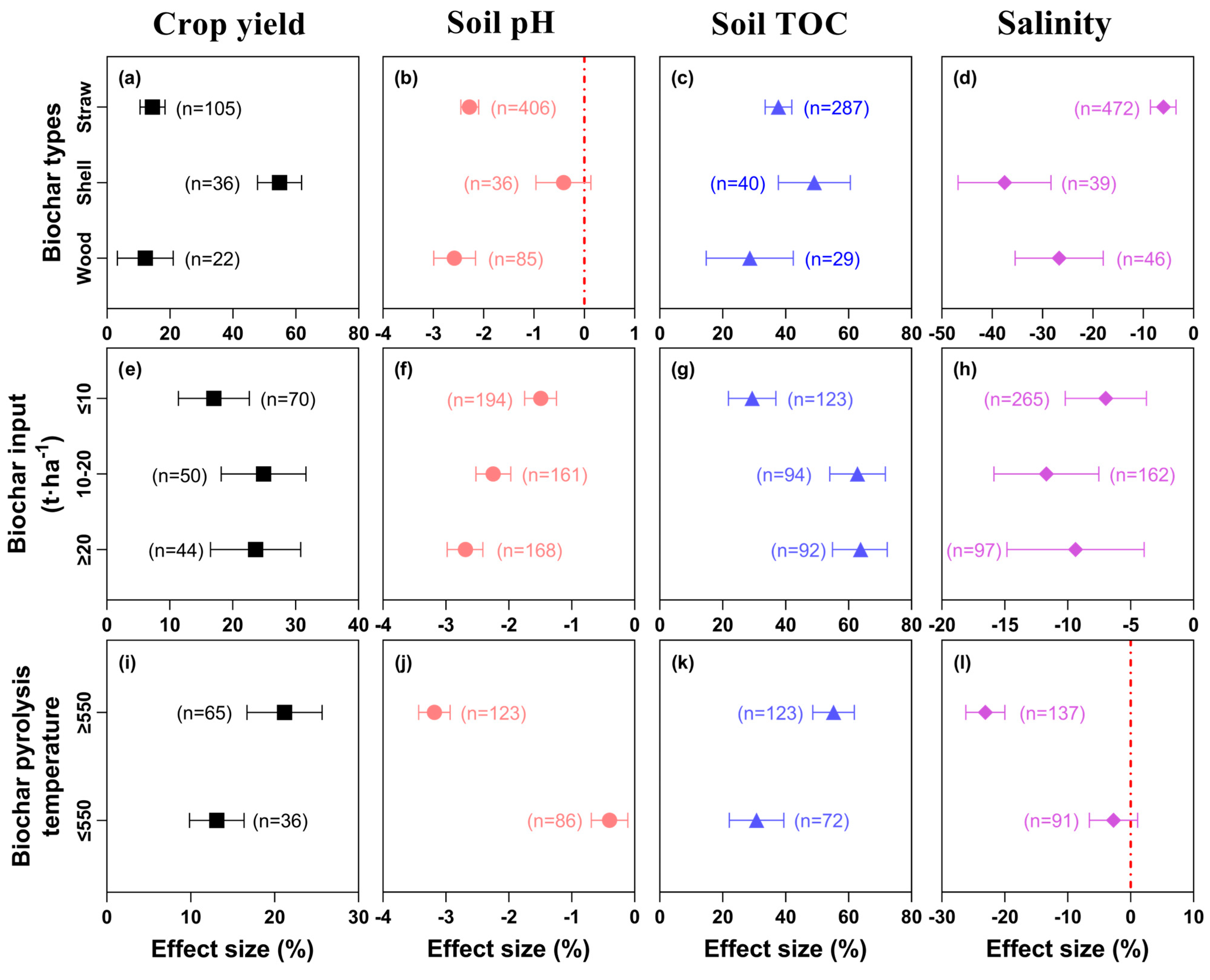
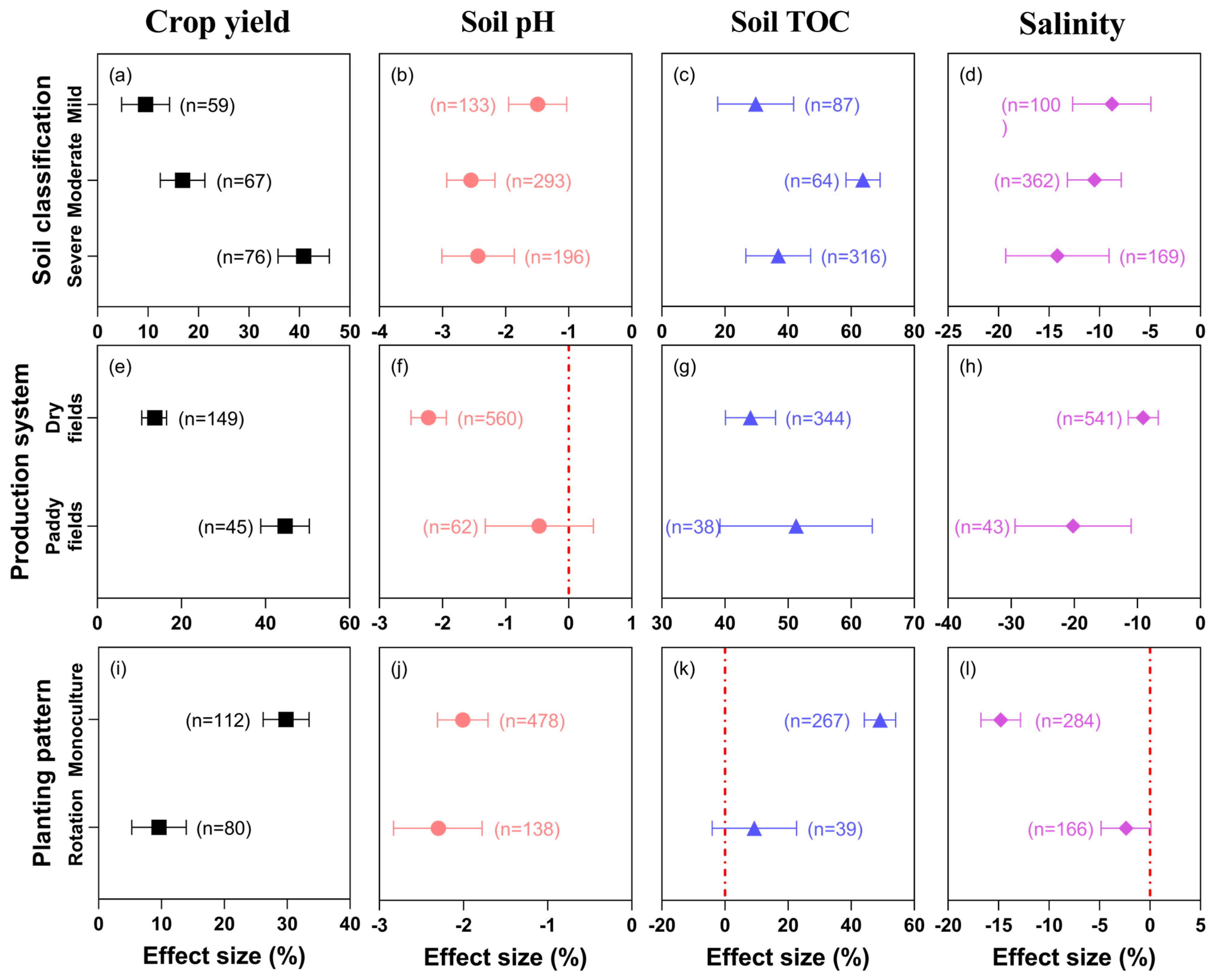


| Items | Variables | Groups | ||
|---|---|---|---|---|
| Climate conditions | MAT (°C) | ≤10 | 10–15 | ≥15 |
| MAP (mm) | ≤400 | 400–800 | ≥800 | |
| Soil classification | Mild | Moderate | Severe | |
| Agricultural practices | Biochar input (t ha−1) | ≤10 | 10–20 | ≥20 |
| Biochar types | Straw | Shell | Wood | |
| Biochar pyrolysis temperature (°C) | ≤550 | ≥550 | ||
| Production system | Dry fields | Paddy fields | ||
| Planting pattern | Monoculture | Rotation | ||
| Crop types | Rice | Maize | Wheat | |
| Sorghum | Soybean | Cotton | ||
| Peanut | ||||
| Subgroups | Crop Yield | Soil pH | Soil TOC | Soil Salinity | ||||
|---|---|---|---|---|---|---|---|---|
| F | p | F | p | F | p | F | p | |
| Soil classification (S) | 25.916 | 0 ** | 10.044 | 0 ** | 2.395 | 0.095 | 6.287 | 0.002 ** |
| Biochar type (B) | 53.900 | 0 ** | 0.723 | 0.486 | 8.814 | 0 ** | 3.698 | 0.025 * |
| Planting pattern (P) | 0.583 | 0.446 | 1.337 | 0.248 | 6.359 | 0.013 * | 0.057 | 0.811 |
| S × B | 31.958 | 0 ** | 4.621 | 0.001 ** | 6.601 | 0 ** | 11.508 | 0 ** |
| S × T | 0.030 | 0.97 | 1.931 | 0.165 | 6.89 | 0.01 * | 0.186 | 0.831 |
| B × T | 1.823 | 0.192 | 0.705 | 0.401 | 8.921 | 0 ** | 7.037 | 0.013 ** |
| S × B × T | 37.892 | 0 ** | 1.457 | 0.228 | 7.267 | 0.01 * | 9.989 | 0.001 ** |
| Water Use Efficiency and Greenhouse Gas Emissions | Pair of Observations | Mean Effect Size (%) | 95% Confidence Interval |
|---|---|---|---|
| Water use efficiency | 266 | 8.7 | [6.7, 10.7] |
| CO2 emissions | 198 | 9.8 | [1.6, 18.1] |
| CH4 emissions | 21 | 31.6 | [24.6, 38.5] |
| N2O emissions | 31 | −29.4 | [−42.3, −16.5] |
Disclaimer/Publisher’s Note: The statements, opinions and data contained in all publications are solely those of the individual author(s) and contributor(s) and not of MDPI and/or the editor(s). MDPI and/or the editor(s) disclaim responsibility for any injury to people or property resulting from any ideas, methods, instructions or products referred to in the content. |
© 2025 by the authors. Licensee MDPI, Basel, Switzerland. This article is an open access article distributed under the terms and conditions of the Creative Commons Attribution (CC BY) license (https://creativecommons.org/licenses/by/4.0/).
Share and Cite
Zhang, L.; Bate, B.; Cui, J.; Feng, Y.; Yu, J.; Cui, Z.; Wang, H.; Li, Q. Biochar Input to Saline-Alkali Farmland Can Improve Soil Health and Crop Yield: A Meta-Analysis. Agriculture 2025, 15, 561. https://doi.org/10.3390/agriculture15050561
Zhang L, Bate B, Cui J, Feng Y, Yu J, Cui Z, Wang H, Li Q. Biochar Input to Saline-Alkali Farmland Can Improve Soil Health and Crop Yield: A Meta-Analysis. Agriculture. 2025; 15(5):561. https://doi.org/10.3390/agriculture15050561
Chicago/Turabian StyleZhang, Liqiang, Baoyin Bate, Jinhu Cui, Yudi Feng, Jianning Yu, Zhengguo Cui, Hongyu Wang, and Qiuzhu Li. 2025. "Biochar Input to Saline-Alkali Farmland Can Improve Soil Health and Crop Yield: A Meta-Analysis" Agriculture 15, no. 5: 561. https://doi.org/10.3390/agriculture15050561
APA StyleZhang, L., Bate, B., Cui, J., Feng, Y., Yu, J., Cui, Z., Wang, H., & Li, Q. (2025). Biochar Input to Saline-Alkali Farmland Can Improve Soil Health and Crop Yield: A Meta-Analysis. Agriculture, 15(5), 561. https://doi.org/10.3390/agriculture15050561






